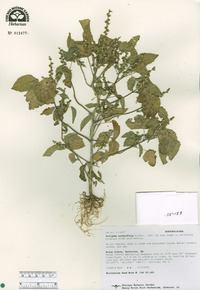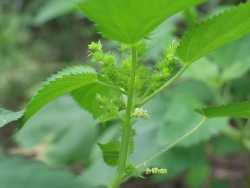|
Family: Euphorbiaceae
pineland threeseed mercury
[Acalypha ostryifolia Riddell ex J.M.Coult.] |
Plant: annual herb; to 70 cm tall; stems erect, branched, with short recurved hairs and stalked glands, especially toward the apex Leaves: ovate, 3-8 cm long, 1.5-5 cm wide, sparsely pilose; apex acute to short attenuate; base cordate or rounded; margin serrate; almost as long as the blade, petioles with pubescence like the stems INFLORESCENCE: SPIKES of two kinds: staminate spikes axillary, 5-35 mm long on pedicels 5-15 mm long; pistillate spikes terminal (sometimes on short lateral branches and so appearing axillary), 3-7 cm long, fairly open, especially in fruit; bracts subtending pistillate flowers 3-6 mm long, with (9-)13-17 narrow lobes about 2/3 the length of the bract, densely glandular with both sessile and stalked glands Flowers: ALLOMORPHIC FLOWERS sessile; ovary obovoid, pubescent, with two irregular flanges near the apex Fruit: capsules, ca. 2 mm long, ca. 4 mm wide, sparsely short hispid and with fleshy green glandular outgrowths especially toward the apex. SEEDS 1.6-2 mm long, brown, with low bumpy ridges Misc: Moist areas, often weedy; 1000-1650 m (3200-5500 ft); Aug-Oct REFERENCES: Levin, Geoffrey A. Euphorbiaceae. Part 1. Acalypha and Cnidoscolus. J. Ariz. - Nev. Acad. Sci. 29(1): 18. Erect, 3-6 dm, branched above, finely hairy; lvs widely spreading or often drooping, thin, ovate-oblong to broadly ovate, abruptly short-acuminate, finely and regularly toothed, rounded to cordate at base; pistillate fls in terminal spikes 3-8 cm, also a few in the axillary staminate clusters; bracts tending to embrace the fr, cleft to about the middle into 13-17 linear segments; fr deeply 3-lobed, 3-4 mm thick, beset with slender projections and also ±pubescent. A weed in grain-fields, gardens, and waste places; N.J. to Ind. and Neb., s. to Fla. and Tex.
Gleason, Henry A. & Cronquist, Arthur J. 1991. Manual of vascular plants of northeastern United States and adjacent Canada. lxxv + 910 pp.
©The New York Botanical Garden. All rights reserved. Used by permission. Wiggins 1964 Duration: Annual Nativity: Native Lifeform: Forb/Herb General: Erect, simple to ascending branched annual 10-80 cm tall with dark green minutely puberulent to glabrate stems and foliage. Leaves: Slender petioles 1-7 cm long, blades ovate 2-6 cm wide, 2.5-12 cm long, obtuse, rounded, sometimes subcordate at base, acute to short-acuminate at apex, serrate, thin, becoming sparsely puberulent to nearly glabrous and puncticulate in age. Flowers: Slender axillary staminate spikes 1-3 cm long, flowers separate below, densely crowded above middle; pistillate spikes terminal on branches 2-7 cm long, bracts 5-9 mm in diameter, lobed one-half to two-thirds of way to base into 11-15 narrowly subulate-linear lobes, these closely beset with short-stiped, nearly granular glands. Fruits: Depressed-globose capsule 3.5-4.5 mm wide, 2-3 mm high, strongly 3-lobed, papillose and muricate on upper surface. Ecology: Found along washes, in shade of shrubs and in wet cienegas; 3,000-5,500 ft (914-1676 m); flowers June-October. Distribution: Most of eastern US, from AZ north to NE east to NJ; south to s MEX and in S. Amer.� Notes: Distinguished as being dark-green erect annuals with finely dentate, ovate leaves; dense inflorescence spikes with densely-stacked flowers which are subtended by leaf-like bracts; the comb-like teeth on bracts below female (pistillate) flowers help to tell this species apart. Ethnobotany: Unknown Etymology: Acalypha is from Greek akalephes for nettle, while ostryifolia might mean having leaves like the genus Ostrya. Synonyms: Acalypha caroliniana Editor: SBuckley 2010, FSCoburn 2015 |

.JPG)

